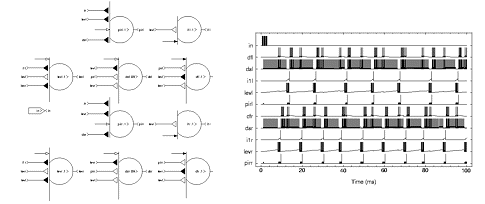Spike and Neuralog - Introduction
At Caltech, I developed a fast event-driven simulator,
called Spike,
for simulating large networks of simple spiking neurons.
You can enter your neural circuit graphically or textually, and
view the simulation output logic-analyzer-style, as shown below.

The above circuit is an Adapting Tonic Burster. That is, it has
bursting response based on a tonic input current, and it has an
inhibitory feedback path that causes its firing rate during a burst
to decrease, or adapt. The circuit demonstrates the use of the
summating synapse feature of Spike, which in this case is used to
model a calcium-dependent potassium channel, to create the adapting
behavior.

The above circuit is a locust walking circuit developed by Sylvie
Ryckebusch in 1991. This was the first use of Spike to model a real biological
circuit.
Spike and Neuralog - Software Release
Spike is a fast event-driven
simulator, written by Lloyd Watts,
optimized for networks of spiking neurons.
Neuralog is a customization of the program Analog, by John Lazzaro and
Dave Gillespie, that can be used for entering neural circuits into your
computer.
The latest release of spike/neuralog is available in spike.zip.
CHANGELOG shows the revision
history.
Spike is distributed under the GNU General Public Licence, which is included
in this distribution, in the file spike/src/COPYING. This software is
distributed WITHOUT ANY WARRANTY.
The file INSTRUCTIONS contains
instructions on how to install Spike and Neuralog, and
how to get started with a simple example circuit.
brochure.pdf
is a more tutorial description of the capabilities of
neuralog and spike.
It is assumed that you
already have AnaLOG and View, two components of the Caltech chipmunk tools
running on your system, and that you are
familiar with their use.
Alternatively, you may use some other data viewing program to look at
the data, such as GnuPlot, Mathematica, and Xvgr.
Alternately, you can avoid the use of AnaLOG/NeuraLOG altogether by specifying
your schematic with a text editor.
Lloyd Watts
|



